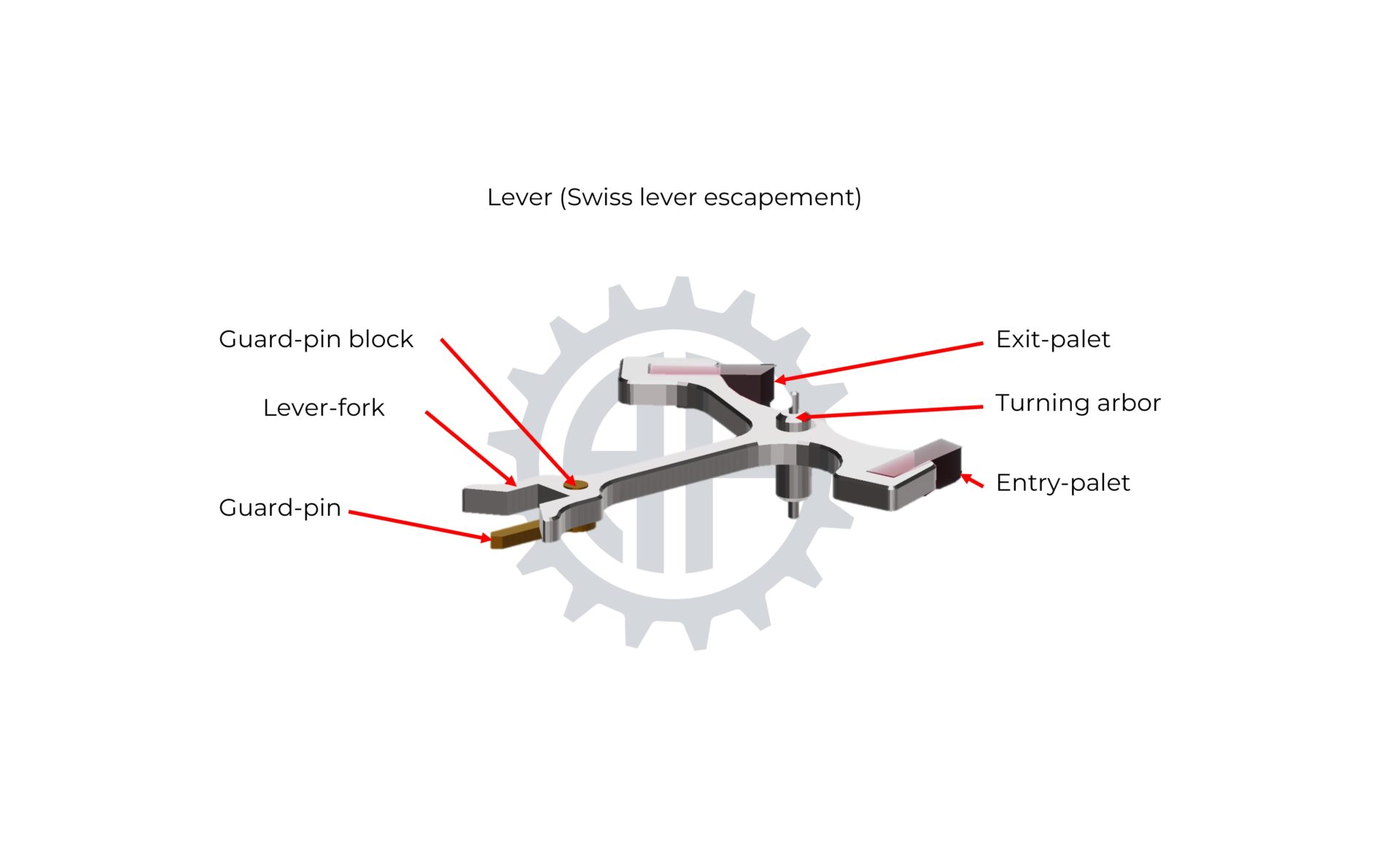LEVER

With the escapement wheel and the double plate, the lever is a component of the escapement. The shape of the lever and its interaction with the escapement wheel and the double plate (itself integral to the balance staff) allow it to transform the rotational movement of the gear train into an oscillatory movement. Additionally, when the balance wheel freely oscillates, the lever pallets block the escapement wheel and, consequently, the entire gear train and the barrel.
The lever (or anchor) gets its name from its shape and appears in different types of escapements. The lever of the Swiss lever escapement has two ruby pallets that successively block the teeth of the escapement wheel. When the balance wheel completes its free oscillation, the pallet staff releases the lever, which pivots slightly. The tooth of the escapement wheel, previously blocked, imparts its impulse to the lever in a brief rotational movement through the impulse plane of the lever. This, in turn, is directly transmitted to the balance wheel by the lever fork located opposite the pallets.
The lever plate is usually made of steel or, nowadays, silicon. It is typically screwed onto the Pallet-staff (its axis). The fork is cut directly into the lever plate. At its base, the brass guard-pin is inserted into the centre of the fork on the lower plane. The fork and the guard-pin transmit the impulses received from the escapement wheel to the balance spring. Conversely, they are disengaged by the impulse jewel to release the energy of the movement and receive a new impulse.
The fork works with the impulse jewel and the bigger roller. The guard-pin works with the smaller roller. While the fork and the impulse jewel enable disengagement and impulse functions, the fork in its interaction with the bigger roller and the guard-pin in its interaction with the smaller roller secure the escapement during shocks that would otherwise block the entire mechanism due to a tipping phenomenon.
The use of a lever in different types of clock escapements and later in watches dates back to the early 18th century when Thomas Mudge invented the Swiss lever escapement in 1754. This type of escapement has been widely used since the dawn of the 20th century. The lever, however, has not undergone significant evolutions since its invention.
Until the late 19th century, watchmakers frequently compensated for the balance defects of the lever, resulting from its asymmetrical shape, by adding a counterweight. It was revealed that it is preferable to prioritize the lightness of the lever over its balance, and counterweights were subsequently abandoned.
Other historical milestones are related to the materials used. Thus, the lever pallets, once made of natural ruby, have been replaced by synthetic corundum since the mid-20th century, as have all the stones in a watch. Finally, the advent of silicon in the early 21st century allowed the production of lighter, more robust, and non-magnetic levers.
The most artisanal method to manufacture a lever involves tracing and then cutting the lever profile from a steel plate using a hacksaw. Final dimensions are achieved through filing and smoothing surfaces. The block that’s holding the guard-pin is transferred and fixed to the lever plate by two feet for precise and stable positioning. The cylindrical guard-pin at the block is flattened by forging and filing to ensure its function. The pallet-staff is turned and then pivoted.
Old manual machines or more modern motorized ones can be used to grind the ruby pallets to their exact dimensions and control the angle of the impulse planes. Once the lever components are manufactured and decorated, the craftsman proceeds to its assembly. The guard-pin is driven into its block, the plate is usually screwed onto the lever-staff, and the pallet stones are held in their position by shellac, which, when heated slightly, allows for the exact adjustment of each pallet’s position and firmly secures it when cool.
On an industrial scale, the lever staff is turned on a screw machine before its pivots are rolled. Stamping is particularly suitable for the fabrication of the plate, although it can also be machined. The pallets are produced on automatic machines with diamond grinders. Depending on the level of finishing required, the lever rolls may be polished by hand or in polishing drums. Finally, the use of glue to fix the pallets now supersedes shellac in industrial production.
The hi-tech method only concerns the lever plate, with its other components being manufactured using materials and industrial methods. The material (silicon) and the manufacturing process described here are identical to those used in the production of integrated circuits. Introduced in watchmaking at the very beginning of the 21st century, this method offers numerous advantages. The principle is to cut (engrave) a silicon plate to a given thickness (generally that of the finished component) using the photolithographic process. This method allows for the realization of the most complex profiles with a precision reaching the micron. Depending on the size of the components to be made, several hundred pieces can be produced simultaneously on the same substrate plate. The most complex profiles can be obtained without the inconvenience of the radii of a milling tool or even the wire of an electrical discharge machine. As this process exerts no mechanical stress, it is possible to produce very thin components (springs, etc.) or pierce them to limit weight, which is particularly beneficial for the lever. Silicon is harder than steel, has excellent elasticity, and is non-magnetic. The progress of this technology and its success make it increasingly attractive in terms of production costs and tend to become widespread for the manufacture of many components (especially for the escapement and the regulating organ).
